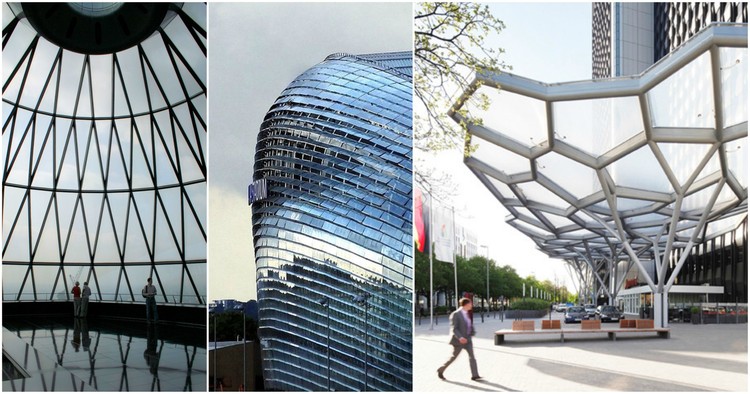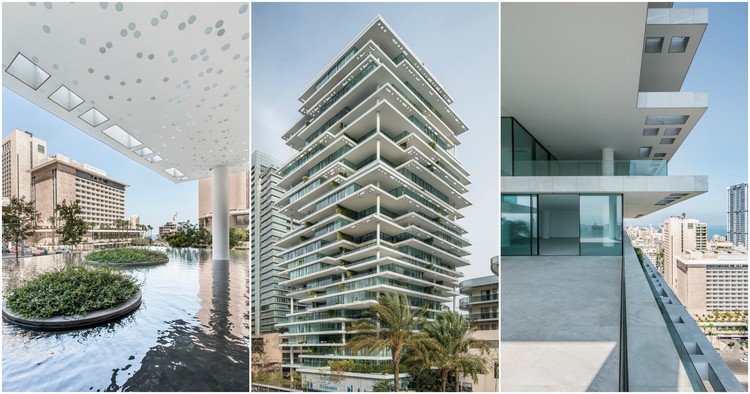Today, Michel Rojkind is widely known as one of Mexico's most successful, and at times flamboyant, architects of the 21st century. But in spite of his success, his path to architecture was never straightforward; before founding Rojkind Arquitectos, he spent over a decade as a drummer in pop-rock band Aleks Syntek y La Gente Normal, an experience which he actually credits with sparking his interest in architecture. An article released this week by Surface Magazine offers an extensive profile of Rojkind, from his childhood, through his days as a drummer, to the difficulties he experienced on his architectural work--including the disastrous opening of Mexico City's Cineteca Nacional in 2014. Read some excerpts from Surface Magazine's article after the break.
Editor's Choice
Inside the Rock 'n' Roll Life of Mexican Architect Michel Rojkind
The Renovation of Louis Kahn's Yale University Art Center: A Significant Moment for Architectural Preservation

This article was originally published by Common Edge as "How the Restoration of Louis Kahn’s Yale Art Gallery Helped Kickstart Modern Preservation."
I have a distinct memory from my days as an architecture student at the University of California Berkeley in the late ‘80s. During an architectural survey class taught by Spiro Kostof, Louis I Kahn’s Yale University Art Gallery popped up in the slideshow. “Nice building,” I thought, “but what’s with those windows?”
Fifteen years later at Polshek Partnership (now Ennead Architects), I would become the project architect for the construction phase overseeing the rehabilitation of that classic building—the most challenging aspect of which was to replace “those windows.” I came to understand, intimately, how the double-paned window wall had failed almost as soon as construction was complete. Condensation accumulated between the panes, creating the foggy effect that marred my first impression of this groundbreaking building.
5 Innovative Business Models for Young Architectural Practices

The architecture profession is in a perpetual debate concerning the myriad issues that impact how we practice and how that work can and should impact the world around us. As the chair of the AIA’s Young Architects Forum, I am keenly aware of the problems facing the next generation of practice leaders: inefficient practice models that lead to overworked, underpaid, and highly unsatisfied staff. We hear repeatedly that a seismic shift in the way firms operate is necessary to successfully move the profession forward and retain talent.
In October, the AIA held their first ever Practice Innovation Lab, looking to develop new practice models to raise the value of architects and the services that they provide to their clients with the goal of sparking a new debate that could challenge the status quo in firm management.Ten teams of six were formed with the intent of creating 10 new innovative practice models which would be pitched, “Shark Tank” style, after a daylong hackathon. Attendees then voted on the best practice model for the People’s Choice Award. Among the 10 pitches, there were five major themes to come out of the Practice Innovation Lab, which are discussed in more detail below:
Sharing the City: 5 Takes on How We Should Create and Use Public Space
On December 1st 2017, reSITE invited a handful of intellectuals to Berlin for the My City / Your City salon held in partnership with Airbnb, spending a day and night with them brainstorming about public space, sharing, and inclusiveness. To close the event, we served them a cocktail of simple questions that were not always easy to answer.
In the following text, artist Charlie Koolhaas, the architect and founding partner of Topotek 1 Martin Rein-Cano, the curator and writer Lukas Feireiss, the curator and architect Anna Scheuermann, and the professor Ivan Kucina, share their various opinions on issues ranging from how best to create public space to their thoughts on the very principle of sharing.
Neat and Tidy or Messy and Cluttered: Which Inspires More Creativity?

While architects are known for promoting sleek, clutter-free spaces, we have to ask: is this the best way to inspire creativity? Personal preference certainly plays a large part in how you respond to a stark table-tops with nary a stray pencil--maybe this is your nirvana. Or perhaps it’s theoretically preferable but once you have to sit down and work, you find yourself uninspired.
Author Tim Harford researched and compiled a number of examples for his book Messy in which “creativity, responsiveness, [and] resilience” were “integral to the disorder, confusion and disarray.” Do you agree? Or perhaps more importantly, what are you surrounded by when you’re in the zone and at your creative peak?
Was the AIA's Failure to Give its Twenty-Five Year Award In 2018 a Snub to Postmodernism?

This article was originally published by Common Edge as "Did the AIA Take a Pass on Postmodernism?"
People perceive architecture in different ways. “Style” is often an easy classification, traditional or modern. Popular residential work is often categorized dismissively by architects as “vernacular.” The branding of the product of the profession, an oeuvre of work embodied in buildings and their meaning in our culture as celebrated by the American Institute of Architects, has many levels of recognition, from local AIA Chapter Awards, to national Awards.
No AIA Award has more meaning or lustre inside the profession than the “Twenty-five Year Award” for buildings that have “stood the test of time.” The award has been given continuously for the last 56 years. This year, the Design Jury chosen to select a seminal building has opted not to give an award to anything, any building 25-35 years old.
Demolition Begins on Lobby of Philip Johnson's AT&T Building
.jpg?1516086194)
While the exterior of Philip Johnson’s iconic AT&T awaits its fate in an upcoming New York City landmarks designation hearing, demolition of its granite-clad interior lobby has already begun.
Citing the fact that the lobby had already been altered in the 1990s – including the removal of the “Golden Boy” statue – when the building switched tenants from AT&T to the Sony Corporation, the Landmarks Preservation Commission decided last month that the interiors were not deserving of landmark status.
Fact Check: Which of These Architecture Rumors are Actually True?

Fact-checking website Snopes (also known as the internet's first fact-checking website) has now been debunking Urban Legends and setting the record straight when it comes to "questionable" and/or fantastic stories for 23 years. In its two decades of operation, it has amassed not only thousands of well-researched explanations to perplexing myths but has also garnered the praise of news outlets like The New York Times, CNN, and Forbes. So what can Snopes tell us about our dear profession? Get your facts right with our list of dubious (and some not-so-dubious) claims about architecture, buildings, and city design.
Will Bamboo Ever Achieve Widespread Use in the Construction Industry?

After years of publishing projects and articles related to bamboo, we are strongly aware of its qualities as a construction material. But is it really an option that you would use into your next project? Despite widespread appreciation, bamboo seems to be a material that is rarely considered for use in everyday designs.
The team of Manasaram Architects and CGBMT asked themselves the same question. Together they are seeking to understand the current perceptions of bamboo and to discover its potential as a commonly-used material in the construction sector. To help in this pursuit, they have shared a survey with us which seeks to evaluate how often architects and building professionals use bamboo, the problems they face, and how informed they are about the material.
We would like to invite our readers to spare 10 minutes of their time to help us expand knowledge about the use of bamboo using the survey below. The results will be shared on ArchDaily once the study is complete.
Tatiana Bilbao: “Architecture Should Benefit Every Single Human Being on This Planet”

As part of a generation of designers that have, in recent years, put Mexico on the map, Tatiana Bilbao is an architect that is increasingly part of the profession’s global consciousness. But, while some Mexican architects have made their mark with spectacular architecture following the international trend of “iconic” architecture, Bilbao opted instead for a more people-focused approach. In this interview, the latest in Vladimir Belogolovsky’s “City of Ideas” series, Bilbao explains how she got into this type of community-building architecture, her thoughts on architectural form, and her ambitions for the future.
Vladimir Belogolovsky: The more I talk to architects of your generation or my generation, the more it becomes apparent that architecture has absolutely no boundaries. In other words, architecture is not just about buildings. More and more, architecture is about building communities.
Tatiana Bilbao: Absolutely. For me, that is the most important part of architecture. Architecture is not about building a building; architecture is about building a community.
Postmodern Post-Mortem: Why We Need To Stop Using Architecture's Most Misunderstood Word

We were hoping for it to happen in the early 2000s. We saw it coming with the opening of the exhibition “Postmodernism: Style and Subversion, 1970 – 1990” at the V&A in London in 2011. But now, after recent discussions on the umpteenth supposed “postmodern revival,” it is finally sure: the word “postmodernism” is back and it’s here to stay. But as clear as it is that the word “postmodernism” is once again fashionable, it is not really clear what we mean when using it. Indeed, this word has been used to imply every possible meaning: architects have used it to describe fashionable and “cute” designs, some critics have used it to categorize everything that is colorful, while some theorists have been using it to affirm that, because of this concept, architecture has surrendered to technology or form, becoming nothing more than a caricature of its own presupposed moral values.
Whether we agree with such commentaries or not, there is one thing that we still need to discuss: what does “postmodern” mean? And, even more urgently: what could it mean today? After all, if we have to deal once again with one of the most misinterpreted and contradictory words ever introduced in our field, we should at least discuss what it means, before using it.
How Drones Can Be Used in Architecture (And How To Use Them Without Breaking the Law)

This article was originally published by Archipreneur as "How Drones Can Be Used in Architecture."
Small unmanned aerial vehicles (UAVs), commonly called drones, are gaining in popularity not only among the general public and consumers, but also among professionals working in the AEC industry. We’ve seen ambitious predictions for the use of drones on construction sites, as transportation vehicles and marketing tools.
While this new technology, like 3D printing and robotic fabrication in general, promises to revolutionize the architectural profession, it is useful to know to what extent its practical application can affect the way archipreneurs work. It seems that, for now, drones have great potentials when it comes to several aspects of the profession.
7 Myths in Architectural Detailing that Are Changing in the Digital Age

The recent availability of automated design and production techniques is changing the development of building details. With parametric and algorithmic design methods and the use of digital fabrication, new abilities are required from architects for the design of details, at the same time as new players are beginning to take part in their development.
Although not always given the necessary attention, architectural details are of extreme importance for many aspects of a building. They can define its theoretical expression and technical character, and impact its production process, its assembly method and even its ecological footprint. Contemporary architecture shows a new interest in detailing, which should not be confused with a return to the appreciation of artisanal work.[1] This new interest is related to the recent re-involvement of the architect with the physical making of buildings, as a result of the use of digital technologies.[2] The new “digital master builder” [3] counts on file-to-factory processes, in which the morphology of construction details is directly related to the knowledge of the available production processes.
Photos Capture the Luxurious Life Inside Herzog & de Meuron's Beirut Terraces
.jpg?1515170830)
In the rapidly burgeoning city of Beirut, the post-war building boom is far from over. Much like its middle-eastern neighbors, it boasts of a plump share of designer architecture—as critic Oliver Wainwright refers to it, “a diverse shopping list”. It is here that the Beirut Terraces, a residential complex designed by Herzog & De Meuron, rises up to 119 meters, occupying a prominent place in the city’s skyline. In this collection of photographs by Bahaa Ghoussainy, one sees the Beirut Terraces from within, getting a glimpse of both the interior, as well as the multiple, unique views offered from inside the building.
Renzo Piano: "Creativity is Only Possible When You Share Creativity"
If you are missing the capacity to create emotion, then it doesn’t work, it’s not enough.
– Renzo Piano
In this in-depth biographical video by the Louisiana Channel, Renzo Piano talks about his earliest influences, why traveling is essential, the pleasures of drawing, what creativity really means, how “computers are a bit stupid,” the way “beauty can change the world,” and more.
5 Very Different Ways to Finance the Construction of Tiny Houses

This article originally appeared on Archipreneur as "5 Amazing Tiny Houses and Their Financing Models."
The tiny house movement is taking the housing market by storm, with small homes appearing all over rural and urban areas across the world. They are an affordable and eco-conscious solution to the narrowing housing supply and can offer mobility to an increasing population of young professionals. Tiny houses come in many forms and sizes—from micro-apartments and office spaces, to cabins on wheels and trailers. Similarly, the financing models vary, depending on function, local building codes, size requirements and whether they’re made as commercial products or private housing solutions.
The best option is to design and build the house yourself, using savings instead of worrying about interest rates and debt. Some tiny house manufacturers offer in-house payment solutions to their customers. Other options are RV loans, peer-to-peer lending and crowdfunding. We assembled a list of 5 beautiful tiny houses built for different purposes.
Google Reveals Plans for 1 Million Square Foot BIG-Designed Campus in Sunnyvale, California

Google has unveiled plans for a new campus in the Moffett Park area of Sunnyvale, California that will be located just a few miles from its long-awaited ‘Googleplex’ headquarters in Mountain View. And just like the company’s Mountain View and London campuses in the works, the building has been designed by Bjarke Ingels Group (BIG).
Located at 100 and 200 W. Caribbean Drive, the complex will consist of two terracing buildings containing over 1 million square feet of office space and room for up to 4,500 employees.
5 Emerging Careers in Architecture Technology to Look Out for in 2018 and Beyond

Even with tech like virtual reality, augmented reality, 3D printing, computational design and robotics already reshaping architecture practice, the design community is just scratching the surface of the potential of new technologies. Designers who recognize this and invest in building skills and expertise to maximize the use of these tools in the future will inherently become better architects, and position themselves for entirely new career paths as our profession evolves. It is a uniquely exciting moment for architecture to advance through innovative use of technology. Even just a decade ago, designers with interests in both architecture and technology were essentially required to pursue one or the other. Now, with architecture beginning to harness the power of cutting-edge technologies, these fields are no longer mutually exclusive. Rather than choose a preferred path, today’s architects are encouraged to embrace technology to become sought-out talent.
With much written about how technology is changing the way architects work and the products we can deliver to clients during a project’s lifecycle, there has been less focus on how technology is changing career opportunities in the profession. Architecture companies are now hiring roles that didn’t exist even three years ago. Here’s a look at five emerging career paths design technology will make possible in 2018 and the immediate future.








.jpg?1515171598)
.jpg?1515171343)
.jpg?1515170657)
.jpg?1515171187)




